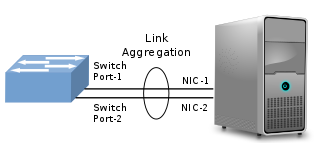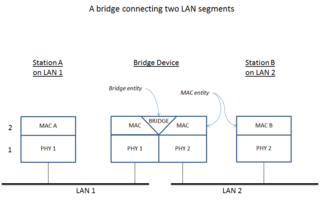A network switch is networking hardware that connects devices on a computer network by using packet switching to receive and forward data to the destination device.
The Spanning Tree Protocol (STP) is a network protocol that builds a loop-free logical topology for Ethernet networks. The basic function of STP is to prevent bridge loops and the broadcast radiation that results from them. Spanning tree also allows a network design to include backup links providing fault tolerance if an active link fails.
A virtual local area network (VLAN) is any broadcast domain that is partitioned and isolated in a computer network at the data link layer. In this context, virtual, refers to a physical object recreated and altered by additional logic, within the local area network. VLANs work by applying tags to network frames and handling these tags in networking systems – creating the appearance and functionality of network traffic that is physically on a single network but acts as if it is split between separate networks. In this way, VLANs can keep network applications separate despite being connected to the same physical network, and without requiring multiple sets of cabling and networking devices to be deployed.
A virtual private network (VPN) is a mechanism for creating a secure connection between a computing device and a computer network, or between two networks, using an insecure communication medium such as the public Internet.
Class of service is a parameter used in data and voice protocols to differentiate the types of payloads contained in the packet being transmitted. The objective of such differentiation is generally associated with assigning priorities to the data payload or access levels to the telephone call.
IEEE 802.1Q, often referred to as Dot1q, is the networking standard that supports virtual local area networking (VLANs) on an IEEE 802.3 Ethernet network. The standard defines a system of VLAN tagging for Ethernet frames and the accompanying procedures to be used by bridges and switches in handling such frames. The standard also contains provisions for a quality-of-service prioritization scheme commonly known as IEEE 802.1p and defines the Generic Attribute Registration Protocol.

A trunked radio system is a two-way radio system that uses a control channel to automatically assign frequency channels to groups of user radios. In a traditional half-duplex land mobile radio system a group of users with mobile and portable two-way radios communicate over a single shared radio channel, with one user at a time talking. These systems typically have access to multiple channels, up to 40-60, so multiple groups in the same area can communicate simultaneously. In a conventional (non-trunked) system, channel selection is done manually; before use the group must decide which channel to use, and manually switch all the radios to that channel. This is an inefficient use of scarce radio channel resources because the user group must have exclusive use of their channel regardless of how much or how little they are transmitting. There is also nothing to prevent multiple groups in the same area from choosing the same channel, causing conflicts and 'cross-talk'. A trunked radio system is an advanced alternative in which the channel selection process is done automatically by a central controller (computer).

In computer networking, link aggregation is the combining of multiple network connections in parallel by any of several methods. Link aggregation increases total throughput beyond what a single connection could sustain, and provides redundancy where all but one of the physical links may fail without losing connectivity. A link aggregation group (LAG) is the combined collection of physical ports.

A metropolitan-area Ethernet, Ethernet MAN, or metro Ethernet network is a metropolitan area network (MAN) that is based on Ethernet standards. It is commonly used to connect subscribers to a larger service network or for internet access. Businesses can also use metropolitan-area Ethernet to connect their own offices to each other.

EtherChannel is a port link aggregation technology or port-channel architecture used primarily on Cisco switches. It allows grouping of several physical Ethernet links to create one logical Ethernet link for the purpose of providing fault-tolerance and high-speed links between switches, routers and servers. An EtherChannel can be created from between two and eight active Fast, Gigabit or 10-Gigabit Ethernet ports, with an additional one to eight inactive (failover) ports which become active as the other active ports fail. EtherChannel is primarily used in the backbone network, but can also be used to connect end user machines.
Cisco Inter-Switch Link (ISL) is a Cisco Systems proprietary protocol that maintains VLAN information in Ethernet frames as traffic flows between switches and routers, or switches and switches. ISL is Cisco's VLAN encapsulation protocol and is supported only on some Cisco equipment over the Fast and Gigabit Ethernet links. It is offered as an alternative to the IEEE 802.1Q standard, a widely used VLAN tagging protocol, although the use of ISL for new sites is deprecated by Cisco.
The Multiple Spanning Tree Protocol (MSTP) and algorithm, provides both simple and full connectivity assigned to any given Virtual LAN (VLAN) throughout a Bridged Local Area Network. MSTP uses BPDUs to exchange information between spanning-tree compatible devices, to prevent loops in each MSTI and in the CIST, by selecting active and blocked paths. This is done as well as in STP without the need of manually enabling backup links and getting rid of switching loop danger.

A network bridge is a computer networking device that creates a single, aggregate network from multiple communication networks or network segments. This function is called network bridging. Bridging is distinct from routing. Routing allows multiple networks to communicate independently and yet remain separate, whereas bridging connects two separate networks as if they were a single network. In the OSI model, bridging is performed in the data link layer. If one or more segments of the bridged network are wireless, the device is known as a wireless bridge.

In networking, a router on a stick, also known as a one-armed router, is a router that has a single physical or logical connection to a network. It is a method of inter-VLAN routing where one router is connected to a switch via a single cable. The router has physical connections to the broadcast domains where one or more VLANs require the need for routing between them.

A computer network is a set of computers sharing resources located on or provided by network nodes. Computers use common communication protocols over digital interconnections to communicate with each other. These interconnections are made up of telecommunication network technologies based on physically wired, optical, and wireless radio-frequency methods that may be arranged in a variety of network topologies.
The Dynamic Trunking Protocol (DTP) is a proprietary networking protocol developed by Cisco Systems for the purpose of negotiating trunking on a link between two VLAN-aware switches, and for negotiating the type of trunking encapsulation to be used. It works on Layer 2 of the OSI model. VLAN trunks formed using DTP may utilize either IEEE 802.1Q or Cisco ISL trunking protocols.
Data center bridging (DCB) is a set of enhancements to the Ethernet local area network communication protocol for use in data center environments, in particular for use with clustering and storage area networks.
IEEE 802.1ad is an amendment to the IEEE 802.1Q-1998 networking standard which adds support for Provider Bridges. It was incorporated into the base 802.1Q standard in 2011. The technique specified by the standard is known informally as stacked VLANs or QinQ.
TRILL is an Internet Standard implemented by devices called TRILL switches. TRILL combines techniques from bridging and routing, and is the application of link-state routing to the VLAN-aware customer-bridging problem. Routing bridges (RBridges) are compatible with and can incrementally replace previous IEEE 802.1 customer bridges. TRILL Switches are also compatible with IPv4 and IPv6, routers and end systems. They are invisible to current IP routers, and like conventional routers, RBridges terminate the broadcast, unknown-unicast and multicast traffic of DIX Ethernet and the frames of IEEE 802.2 LLC including the bridge protocol data units of the Spanning Tree Protocol.






